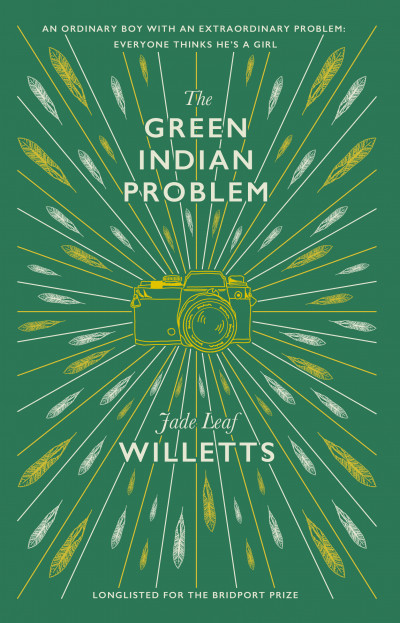The Green Indian Problem
 Publishing as an industry is obsessed with new – books yet to come out… but what about the brilliant books that have already been published? Each month we spotlight a different author whose book was published more than a year ago, which you might be yet to meet… This month we hear from Jade Leaf Willetts about the brilliant The Green Indian Problem…
Publishing as an industry is obsessed with new – books yet to come out… but what about the brilliant books that have already been published? Each month we spotlight a different author whose book was published more than a year ago, which you might be yet to meet… This month we hear from Jade Leaf Willetts about the brilliant The Green Indian Problem…

Shuffling the Shelves: The Green Indian Problem by Jade Leaf Willetts

I started writing The Green Indian Problem with the intention that it would feature a teenage protagonist, but the voice of Green (otherwise known as Jade Waters) came to me like a gift, seemingly fully formed. I recognised this as a rarity, and I felt it was my duty as a writer to abandon my vision of the character and go with it. Once I gave myself over to the younger voice, exploring the world through Green was an addictive writing experience.
As I worked on the novel, my awareness of the inspirations behind the character became clearer. No character comes fully formed, of course. The Green Indian Problem is semi-autobiographical, and I drew on a lot of the traits I had as a child. In essence, Green is a fictionalised version of my seven-and-a-half-year-old self – except I wasn’t quite so articulate or funny. I also drew on conversations I’d overheard children having, which provided snippets of unintentional, original humour. I read compilations of children’s homework, and a book I found, Children’s Letters to God by Stuart Hample, no doubt inspired Green’s letters. There was also an anecdote that stuck with me – about a young boy’s response to seeing Jesus on MTV. In the music video, Jesus is dancing in a nightclub. On seeing this, the boy said, ‘Mam, I saw Jesus on the telly. It’s good to know he’s having a nice time.’ I hadn’t seen Jesus raving to an awful soundtrack, and I wasn’t there when the kid expressed his thoughts on it, but even second-hand it struck me as both funny and sad. I wanted to capture the essence of this reaction through my young protagonist and explore the juxtaposition between naivety and experience, understanding versus misunderstanding. I think it’s this in-between state that makes child narrators endlessly fascinating. Often, young narrators call on the reader to help make sense of their interpretations, to fill in the gaps, or read between the lines. What they don’t quite understand, the reader does. As a reader, I enjoy this kind of narrative, and I wanted to tap into this idea in my work. Green’s version of events is honest but unreliable; he’s a confused kid, constantly trying to make sense of things that are beyond him. He’s wise beyond his years, but he views the world through a lens filtered by the limitations of his age. I hope his skewed point of view makes for an interesting take on the big concepts.
Excerpts from The Green Indian Problem
GENDER
‘I was kind of sad when it was time to go home, because I was having such a nice time. I was also confused, because it is funny when you love someone a lot, but they think you’re a girl and you’re a boy. It’s like they don’t really know you properly, even though they see you all the time.’
IDENTITY
‘When I grow up, I won’t be a nasty man like Den. I’ll be a nice man like the men on the telly. I will have a checked shirt and a nice, clean moustache… I can’t always decide what I want to do, because there are so many good thing to be, but I definitely want to be my real self, which is an M and not an F. Sometimes, when I’m watching a film, I pretend I am the man in it, and then I feel happier because I feel more like myself, a boy. A male and NOT a female.’
FRIENDSHIP
‘Michael is extra nice. He’s my favourite person that’s not in my family. I don’t even care about his black teeth. Sometimes people make fun of him and call him Black Jack, because his teeth look like the sweets, but I don’t. He doesn’t make fun of me for girl things either. You don’t care about each other’s wrong parts when you’re best friends. You even forget to notice.’
FAMILY
‘My family tree was hard to do, because some of my family are living with the wrong people… When Mrs R was teaching us about families, she said that some people can have half brothers and sisters… If Mrs R is right, that would mean my brothers and sisters are halves, but I think that is just stupid, because you can’t have half a sister. Sisters are not like fractions.’
LOVE
‘When you love someone properly, it means you would rather get run over than watch it happen to them. It means you wish they would win a million pound more than you wish you would win it. It means you would give them your last Rolo, or even all of your Rolos, if they were hungry. It means you still like to look at their face even if there is something really good on the telly.’
MARRIAGE
‘Families are confusing, especially when everyone breaks up. I still think people should have better checks for deciding who they like before they get married. If I ever get married, I am going to do loads of tests on the woman to check I like her. The main thing I will check is if she has got brown curly hair, because brown curly hair is my favourite for girls. I would also check if she likes dogs and has got kindness in her eyeballs. You can always tell if people have got kindness in them, because it leaks from their eyes.’
RELIGION
‘On the wall in Nan and Grandad’s flat there is a picture of heaven and hell. It is called THE BROAD AND THE NARROW WAY. It shows one path that leads to heaven and one path that leads to hell. On the way to heaven, there are streams, rainbows and churches, but on the way to hell you can fight, drink beer and ride a horse. The road to hell looks like much more fun, but it’s no fun when you get there. When you get to hell, demons want to drag you into a fire.’
AGE
‘My nan and grandad look much younger than all the other nans and grandads. I saw one lady whose skin was nearly falling off. She looked like Skeletor. I felt sorry for her, but my nan said she was fine. She didn’t look it. She looked like she had died ages ago, but her brain forgot to tell her body to stop walking around.’
GRIEF
‘You can’t tell who got burnt and who got eaten by maggots when you look at the graves. They all look the same. It was weird looking at Grandad’s spot, because it didn’t feel like he was under the dirt. The cemetery was nice, though. It had lots of birds and flowers. Nan was doing zero-noise crying. People always cry when they look at graves, but I don’t know why, because graves are just like cupboards for bones and ashes. I don’t think dead people are really in graves. I think they are in memories and photographs and living inside people’s hearts.’
DEATH
‘When you die, your energy is over. That’s science, not religion. I didn’t say that to Nan, though, because she thinks Grandad is waiting for her in heaven… When you die, it’s like the film of your life has ended… nothing can get better when you’re dead. When you’re alive, you can try to get some help, and you can keep hoping that something good will happen.’
– Jade Leaf Willetts, June 2025


The Green Indian Problem
£10.00
BUY NOW
Set in the valleys of South Wales at the tail end of Thatcher’s Britain, The Green Indian Problem is the story of Green, a seven year-old with intelligence beyond his years – an ordinary boy with an extraordinary problem: everyone thinks he’s a girl.
Green sets out to try and solve the mystery of his identity, but other issues keep cropping up – God, Father Christmas, cancer – and one day his best friend goes missing, leaving a rift in the community and even more unanswered questions. Dealing with deep themes of friendship, identity, child abuse and grief, The Green Indian Problem is, at heart, an all-too-real story of a young boy trying to find out why he’s not like the other boys in his class.
Longlisted for the Bridport Prize (in the Peggy Chapman-Andrews category)

e-book available*

Up next…
We asked Jade to choose the next book to join the shuffled shelves, so join us here to find out more about This Good Book.
Jade said:
A list of thoughts on This Good Book by Iain Hood
- This Good Book is not just a clever title.
- This Good Book is original. A rare feat.
- This Good Book is dark and funny in equal measures.
- This Good Book should be required reading for art students.
- Likewise, creative writing students.
- Read it again. And again. You’ve definitely missed things.
- Buy a copy for the person you’re thinking of.
- This Good Book captures what it feels like to stand in a museum and stare at a painting of Jesus for too long. Another difficult feat.
- This Good Book is the sort of book you don’t know you’re looking for until you find it.
- I’d pay good money to see a film adaptation.
- Mind you, a play would be brilliant.
- But the film soundtrack would be sublime.
- An original score by Mogwai?
- This Good Book deserves recognition. I think it deserves a place in the elusive literary club for modern cult classics.













